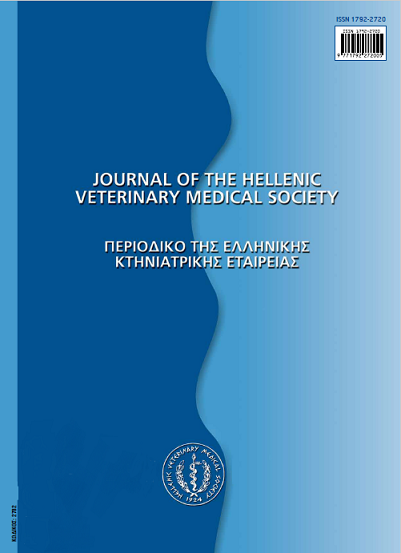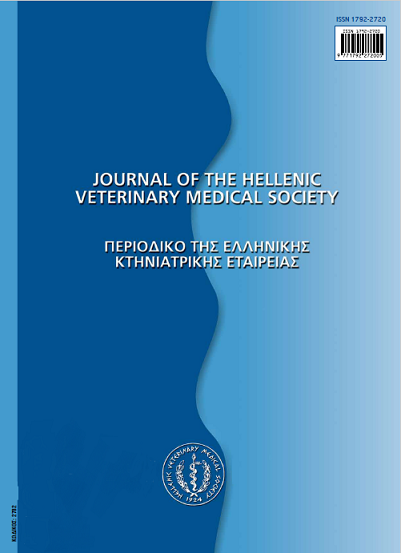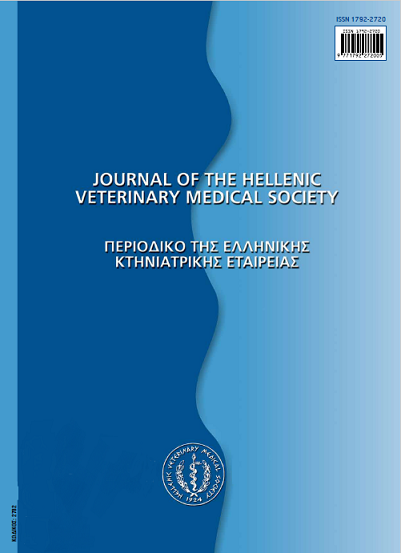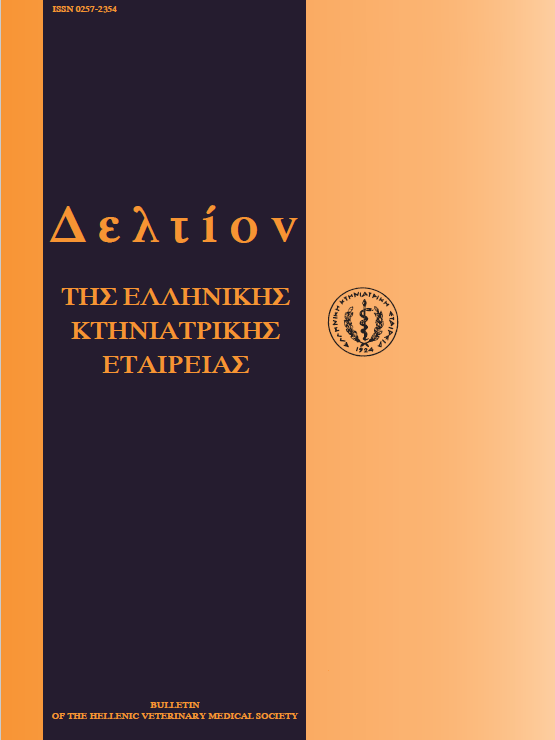Σύνδρομα και διάφορα νοσολογικά προβλήματα του χοίρου που συνδέονται με την προσβολή από τον κυκλοϊό τύπου 2 (PCV2): Νεότερα δεδομένα

Περίληψη
Οι κυκλοϊοί χου χοίρου ανήκουν σχο γένος Circovirus, της οικογένειας των Circoviridae. Δυο τύποι κυκλοϊών έχουν απομονωθεί και ταχτοποιηθεί, ο κυκλοϊός τύπου 1 (Porcine Circovirus type 1/PCVl και ο κυκλοϊός τύπου 2 (Porcine Circovirustype 2/PCV2). Ο PCV1 θεωρείται ως μη λοιμογόνος και δεν έχει συσχεχιστεί μέχρι σήμερα με την εμφάνιση κάποιας παθολογικής κατάστασης. Αντίθετα, ο PCV2 θεωρείται παθογόνος και έχει απομονωθεί από χοίρους που εμφάνισαν διάφορα σύνδρομα και νοσολογικά προβλήματα. Ο PCV2 έχει διαπιστωθεί όχι συμμετέχει στην αιτιοπαθογένεια του Πολυσυστηματικου Συνδρόμου Απίσχνανσης των Απογαλακτισμένων Χοιριδίων (ΠΣΑΑΧ), ενώ σχετίζεται και με το Σύνδρομο Δερματίτιδας και Νεφροπάθειας του Χοίρου (ΣΔΝΧ), αλλά και με άλλα σύνδρομα και παθολογικές καταστάσεις, χωρίς ωστόσο να έχει διευκρινιστεί πλήρως ο βαθμός συμμετοχής του στην αιτιοπαθογένεια τους. Ο PCV2 θεωρείται πλέον από πολλούς ερευνητές ως το κύριο αίτιο πρόκλησης του ΠΣΑΑΧ, ενώ πιστεύεται ότι ο ιός του Αναπνευστικού και Αναπαραγωγικού Συνδρόμου του Χοίρου (ΑΑΣΧ) αποτελεί σημαντικό παράγοντα για την εκδήλωση του συνδρόμου τόσο σε πειραματικές συνθήκες όσο κυρίως σε συνθήκες εκτροφής. Επίσης, η ταυτόχρονη μόλυνση από το Mycoplasma hyopneumoniae, που αποτελεί συχνό εύρημα σε περιστατικά ΠΣΑΑΧ, υποστηρίζεται ότι αυξάνει τη συχνότητα εμφάνισης και τη σοβαρότητα του συνδρόμου. Από τα αποτελέσματα πειραματικών μολύνσεων χοίρων με τον PCV2 διαπιστώνεται ότι για την κλινική εκδήλωση του ΠΣΑΑΧ απαιτείται μεγάλη περίοδος επώασης, καθώς και η δράση άλλων λοιμογόνων παραγόντων. Επιπρόσθετα, η ενεργητική ανοσοδιέγερση μετά από εμβολιασμό θεωρείται ότι είναι δυνατό να προκαλέσει την εμφάνιση του ΠΣΑΑΧ. Η διάγνωση του συνδρόμου στηρίζεται στην κλινική εικόνα και στα ευρήματα της νεκροτομικής εξέτασης, στην παρουσία χαρακτηριστικών ιστοπαθολογικών αλλοιώσεων στους λεμφοειδείς ιστούς και στην ανίχνευση αντιγόνων και νουκλεϊκου οξέως του ίου στις αλλοιώσεις αυτές. Το ΣΔΝΧ έχει ήδη αναφερθεί στις περισσότερες χώρες με ανεπτυγμένη χοιροτροφική παραγωγή. Χαρακτηρίζεται από την εμφάνιση αιμορραγικών δερματικών αλλοιώσεων, απώλεια βάρους, οίδημα των άκρων, αγγειίτιδα και σπειραματονεφρίτιδα και προσβάλλει συνήθως χοίρους ηλικίας 1,5 έως 4 μηνών. Η ανίχνευση των αντιγόνων και του νουκλεϊκου οξέως του PCV2 σε δερματικές και νεφρικές αλλοιώσεις έθεσε την υποψία της συμμετοχής του στην αιτιοπαθογένεια του συνδρόμου, αν και δεν έχει γίνει δυνατή προς το παρόν η πειραματική αναπαραγωγή του. Δεν αποκλείεται βέβαια για την εμφάνιση του συνδρόμου να είναι απαραίτητη η συνεργική δράση και άλλων παραγόντων, όπως ο συνωστισμός, ο ελλιπής αερισμός, η ανάμιξη ζώων διαφορετικών ηλικιών, η ταυτόχρονη λοίμωξη από άλλους παθογόνους μικροοργανισμούς, κ.ά.. Το Αναπνευστικό Σύνδρομο του Χοίρου (ΑΣΧ) αποτελεί σοβαρότατο πρόβλημα υγείας των χοίρων ηλικίας 6-22 εβδομάδων. Στην αιτιολογία του εμπλέκονται τόσο ιογενείς όσο και βακτηριακοί παθογόνοι παράγοντες, όπως ο ιός του ΑΑΣΧ, ο ιός της γρίπης του χοίρου,το Mycoplasma hyopneumoniae, ο Actinobacillus pleuropneumoniae και η Pasteurella multocida. Σε πρόσφατες έρευνες αναφέρεται ότι και ο PCV2 μπορεί να συμβάλλει στην εμφάνιση του ΑΣΧ, πιθανώς αλληλεπιδρώντας ή κυρίως δρώντας συνεργικά με άλλα παθογόνα του αναπνευστικού συστήματος, όπως είναι ο ιός του ΑΑΣΧ. Το ΑΣΧ, που συνδέεται με μόλυνση από τον PCV2, θαπρέπει να διαφοροποιείται από το ΠΣΑΑΧ με βάση τα κλινικά και τα ιστοπαθολογικά ευρήματα. Στη διεθνή βιβλιογραφία υπάρχουν,επίσης, αρκετές αναφορές που συσχετίζουν τη μόλυνση από τον PCV2 με την εμφάνιση διαταραχών της αναπαραγωγικής ικανότητας (αυξημένα ποσοστά αποβολών, θνησιγενών και μουμιοποιημένων εμβρύων) τόσο σε συνθήκες πειραματικές όσο και εκτροφής. Αναφέρεται δε ότι στην αιτιοπαθογένεια της υπερπλαστικής και νεκρωτικής πνευμονίας του χοίρου είναι πιθανό να συμμετέχει η μικτή λοίμωξη από τον ιό του ΑΑΣΧ και τον PCV2. Επιπρόσθετα,έχει ήδη αποδειχθεί, σε πειραματικές μολύνσεις με Staphylococcus hyicus και στην πρόκληση εξιδρωματικής επιδερμίτιδας σε χοίρους, η δράση του PCV2 και του χοίρειου παρβοϊου ως προδιαθετικών παραγόντων για την πρόκληση του νοσήματος. Δεν αποκλείεται, επομένως, οι ιοί αυτοί να συμμετέχουν και στην εκδήλωση και τη σοβαρότητα των αλλοιώσεων της εξιδρωματικής επιδερμίτιδας. Ο ιός συσχετίστηκε επίσης με την εμφάνιση συγγενούς μυϊκού τρόμου των χοιριδίων, κοκκιωματώδους εντερίτιδας, καθώς και με τη νεκρωτική λεμφαδενίτιδα. Η τελευταία αποτελεί ίσως μία νέα πιθανή κλινική εκδήλωση της μόλυνσης από τον PCV2. Πρόσφατα διατυπώθηκε η άποψη ότι πιθανόν για την εμφάνιση του κάθε συνδρόμου ή νοσολογικού προβλήματος είναι υπεύθυνα διαφορετικά στελέχη του PCV2. Αρκετές έρευνες αναφέρουν ότι στελέχη του ίου, που απομονώθηκαν από χοίρουςπου έπασχαν από διάφορα σύνδρομα ή παθολογικές καταστάσεις ,παρουσίαζαν μικρές διαφορές στο γένωμά τους, χωρίς να έχει αξιολογηθεί ακόμη η σημασία των διαφορών αυτών. Ωστόσο, είναι πιθανό οι διαφορές αυτές να επηρεάζουν τον τροπισμό των στελεχών αυτών στους ιστούς του χοίρου. Επίσης, δεν αποκλείεται και άλλοι παράγοντες, όπως η ηλικία, η οδός μόλυνσης, κ.ά., να επηρεάζουν την παθογόνο ικανότητα του ίου, καθώς και το είδος του προκαλουμένου συνδρόμου ή νοσολογικού προβλήματος. Εντούτοις, η παθογένεια του ίου συνεχίζει να παραμένει αδιευκρίνιστη,γεγονός που κάνει απαραίτητη τη συνέχιση των ερευνητικών προσπαθειών προς την κατεύθυνση αυτή.Στην Ελλάδα έχει περιγραφεί και διαγνωσθεί το ΠΣΑΑΧ, καθώς και -για πρώτη φορά στη διεθνή βιβλιογραφία- κρούσματα του συνδρόμου μετά από εμβολιασμό κατά της ενζωοτικής πνευμονίας, το ΣΔΝΧ, ενώ έχει αναφερθεί η «νοσολογική» σχέση ΠΣΑΑΧ και ΑΑΣΧ, καθώς και η αντίστοιχη με το ΑΣΧ. Τέλος, έχει ήδη πραγματοποιηθεί η γενετική ανάλυση των πρώτων στελεχών PCV2, που απομονώθηκαν από χοίρους με διαφορετικά κλινικά σύνδρομα στην Ελλάδα.
Λεπτομέρειες άρθρου
- Πώς να δημιουργήσετε Αναφορές
-
TZIKA (Ε. Δ. ΤΖΗΚΑ) E. D. (2017). Σύνδρομα και διάφορα νοσολογικά προβλήματα του χοίρου που συνδέονται με την προσβολή από τον κυκλοϊό τύπου 2 (PCV2): Νεότερα δεδομένα. Περιοδικό της Ελληνικής Κτηνιατρικής Εταιρείας, 56(3), 256–268. https://doi.org/10.12681/jhvms.15086
- Τεύχος
- Τόμ. 56 Αρ. 3 (2005)
- Ενότητα
- Review Articles
Οι συγγραφείς των άρθρων που δημοσιεύονται στο περιοδικό διατηρούν τα δικαιώματα πνευματικής ιδιοκτησίας επί των άρθρων τους, δίνοντας στο περιοδικό το δικαίωμα της πρώτης δημοσίευσης.
Άρθρα που δημοσιεύονται στο περιοδικό διατίθενται με άδεια Creative Commons 4.0 Non Commercial και σύμφωνα με την άδεια μπορούν να χρησιμοποιούνται ελεύθερα, με αναφορά στο/στη συγγραφέα και στην πρώτη δημοσίευση για μη κερδοσκοπικούς σκοπούς.
Οι συγγραφείς μπορούν να καταθέσουν το άρθρο σε ιδρυματικό ή άλλο αποθετήριο ή/και να το δημοσιεύσουν σε άλλη έκδοση, με υποχρεωτική την αναφορά πρώτης δημοσίευσης στο J Hellenic Vet Med Soc
Οι συγγραφείς ενθαρρύνονται να καταθέσουν σε αποθετήριο ή να δημοσιεύσουν την εργασία τους στο διαδίκτυο πριν ή κατά τη διαδικασία υποβολής και αξιολόγησής της.






